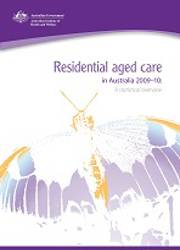Residential aged care in Australia 2010-11: a statistical overview
Citation
AIHW
Australian Institute of Health and Welfare (2012) Residential aged care in Australia 2010-11: a statistical overview, AIHW, Australian Government, accessed 27 April 2024.
APA
Australian Institute of Health and Welfare. (2012). Residential aged care in Australia 2010-11: a statistical overview. Canberra: AIHW.
MLA
Australian Institute of Health and Welfare. Residential aged care in Australia 2010-11: a statistical overview. AIHW, 2012.
Vancouver
Australian Institute of Health and Welfare. Residential aged care in Australia 2010-11: a statistical overview. Canberra: AIHW; 2012.
Harvard
Australian Institute of Health and Welfare 2012, Residential aged care in Australia 2010-11: a statistical overview, AIHW, Canberra.
PDF | 1.7Mb
Residential aged care in Australia 2010-11 provides comprehensive statistical information on residential aged care facilities, their residents, admissions and separations, and residents' dependency levels. At 30 June 2011, there were nearly 185,500 residential aged care places, an increase of more than 2,600 places compared with 30 June 2010. More than 85,200 permanent residents (52%) had a recorded diagnosis of dementia at 30 June 2011. Other recorded health conditions included circulatory diseases (40,000 residents) and diseases of the musculoskeletal and connective tissue (29,400 residents).
- ISSN: 1329-5705
- ISBN: 978-1-74249-343-5
- Cat. no: AGE 68
- Pages: 100
-
At 30 June 2011, there were nearly 186,000 residential aged care places and 169,000 people were in residential aged care
-
Of people in permanent care, 63% of women were aged 85 and over, compared with 43% of men
-
The overall proportion of people aged 85 and over in permanent care increased from 49% in 1999 to 57% in 2011
-
At the same time, in respite care the proportion of people aged 85 and over increased from 36% to 50%.



